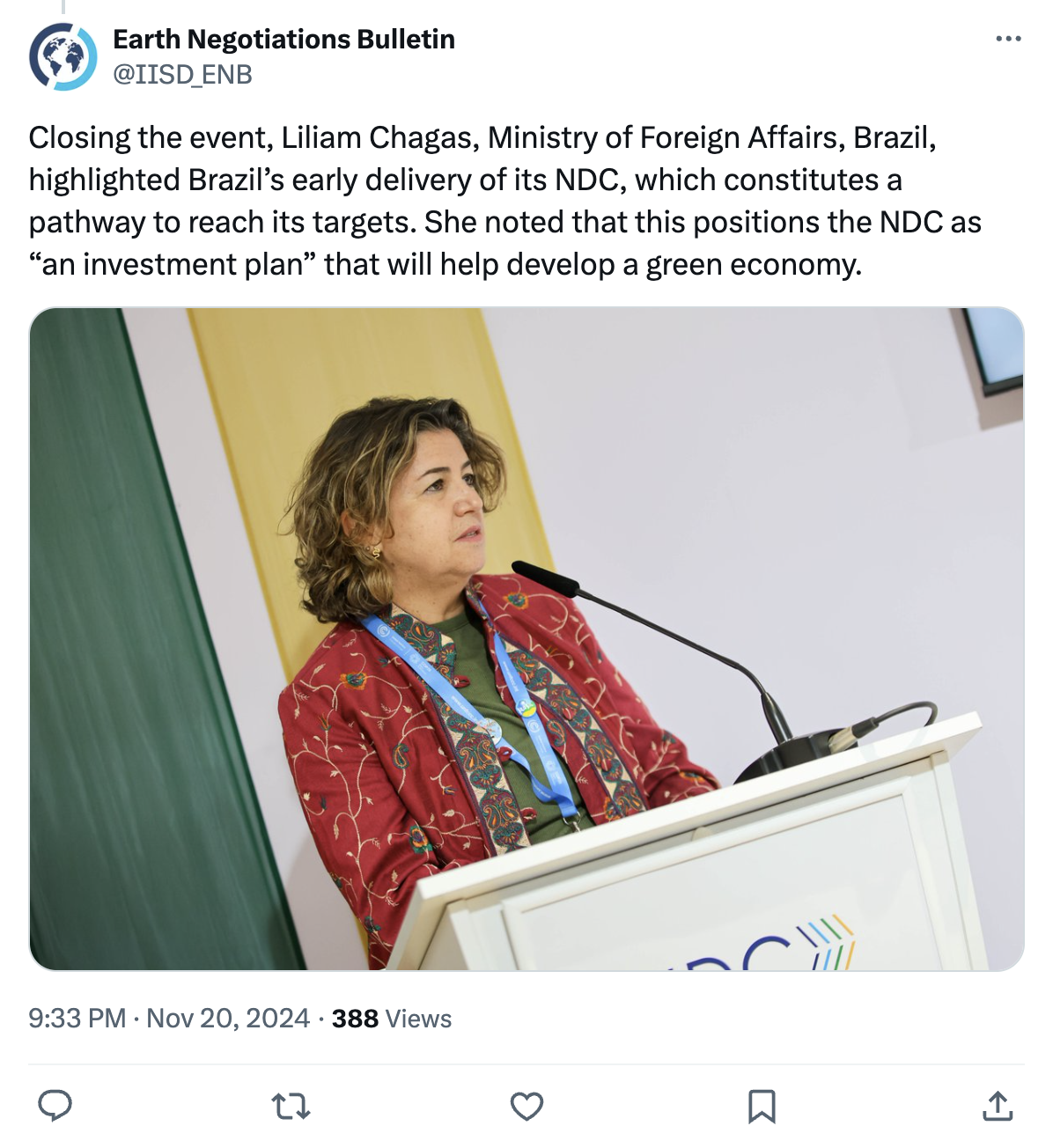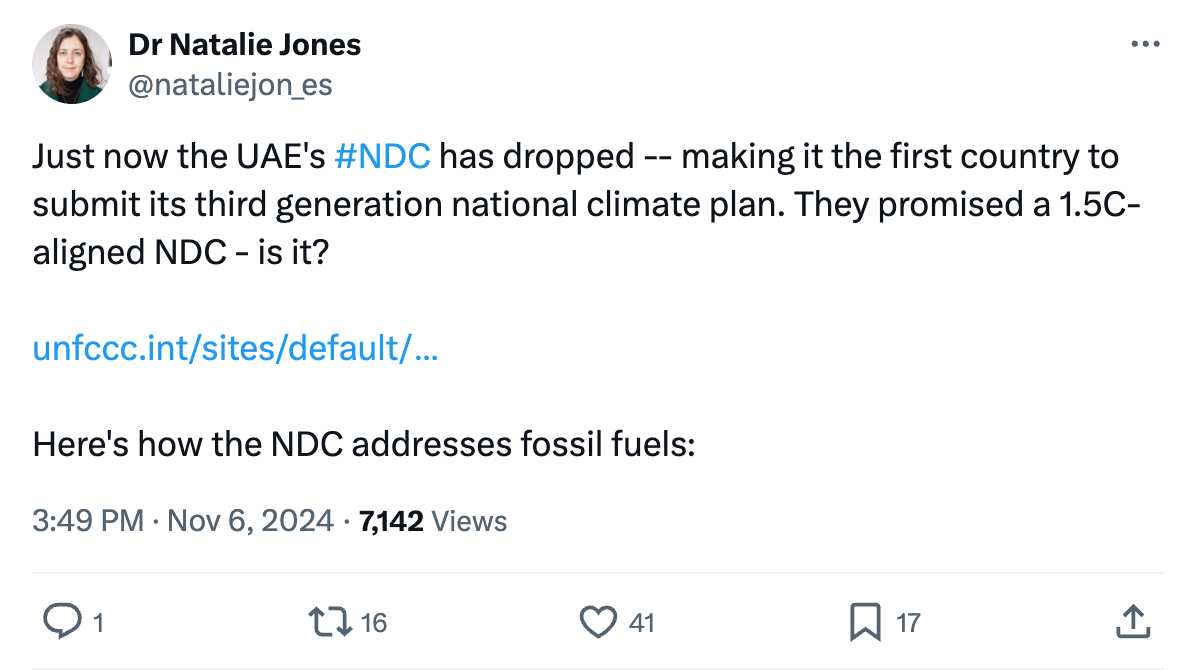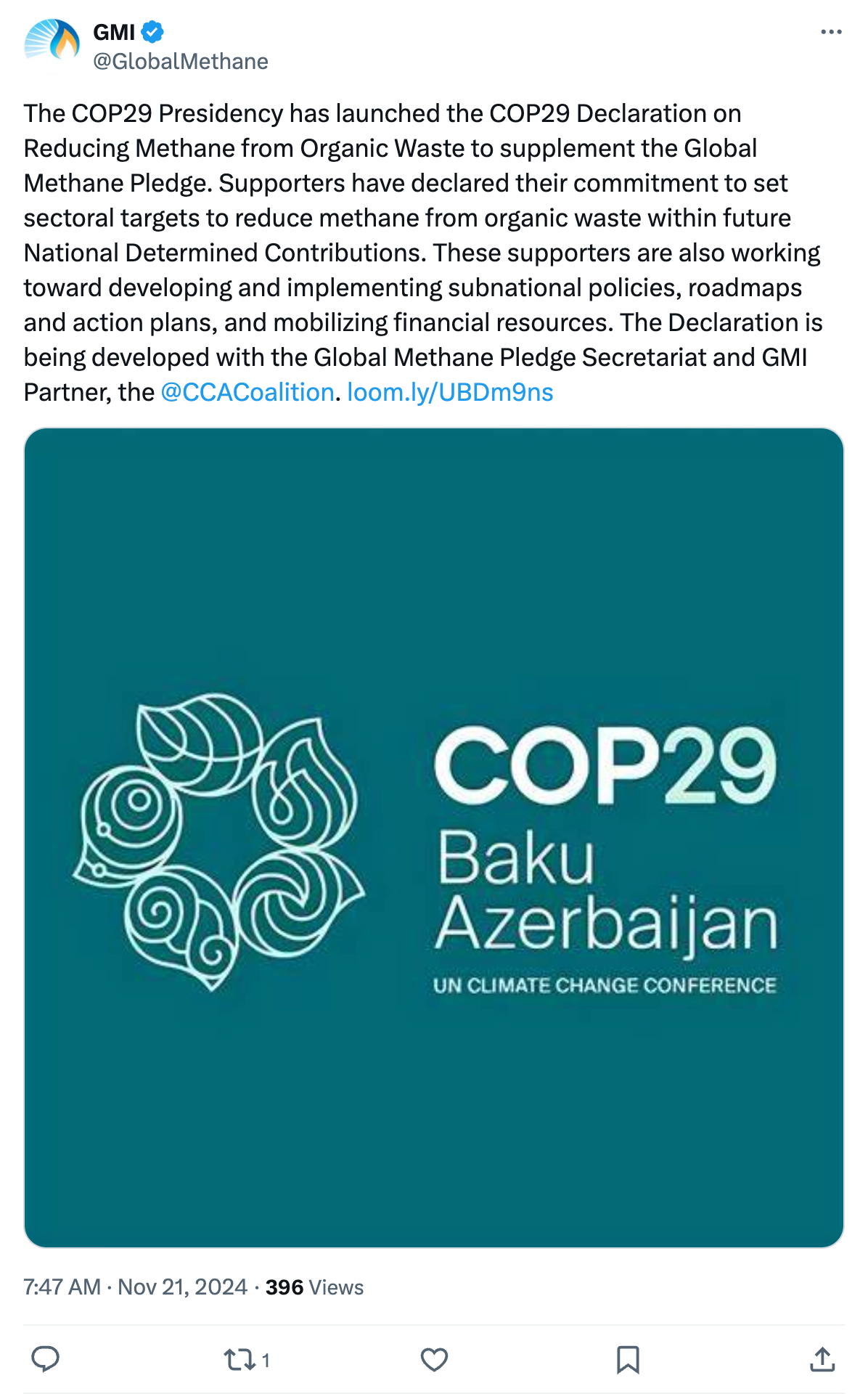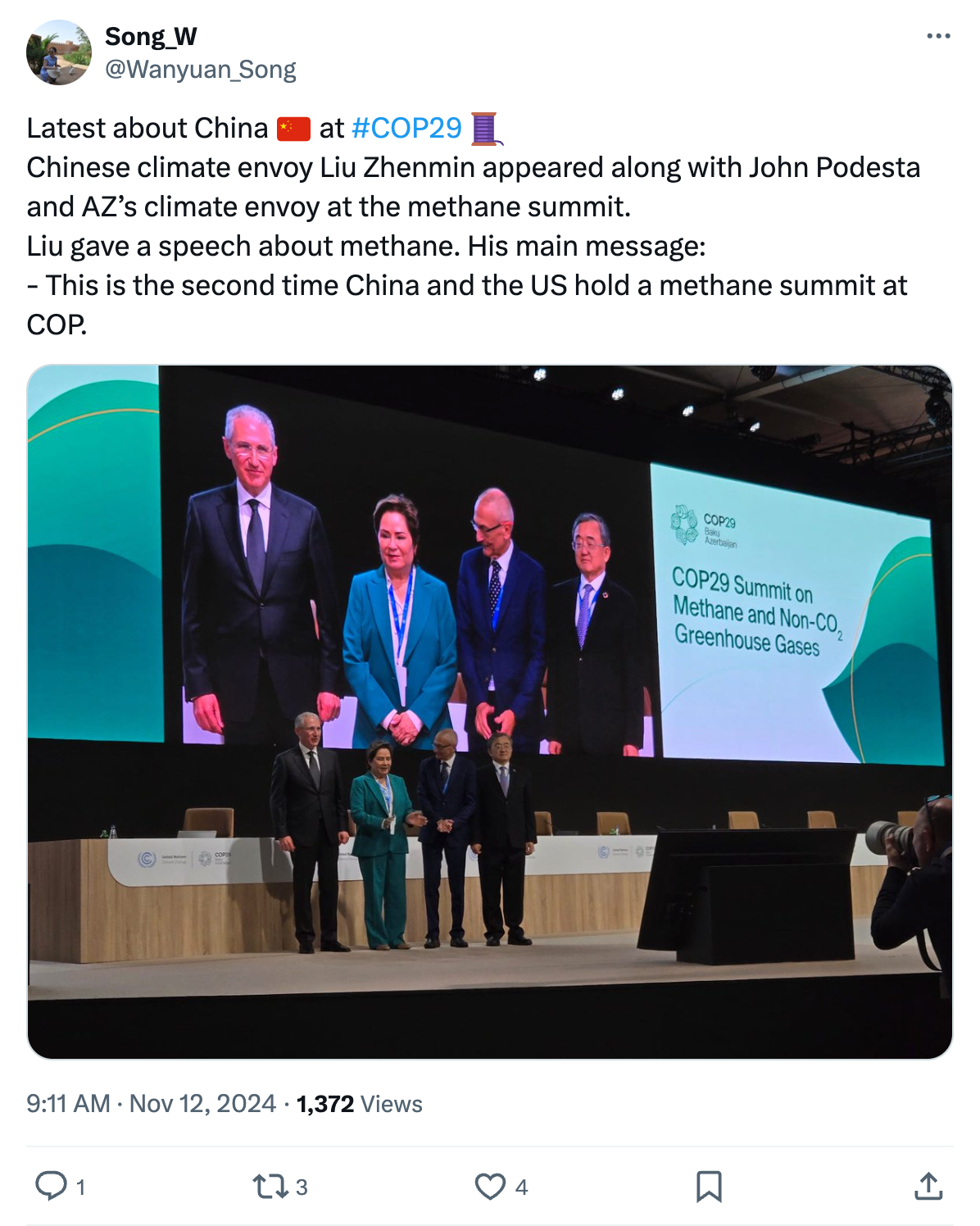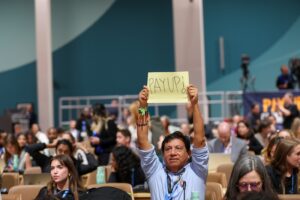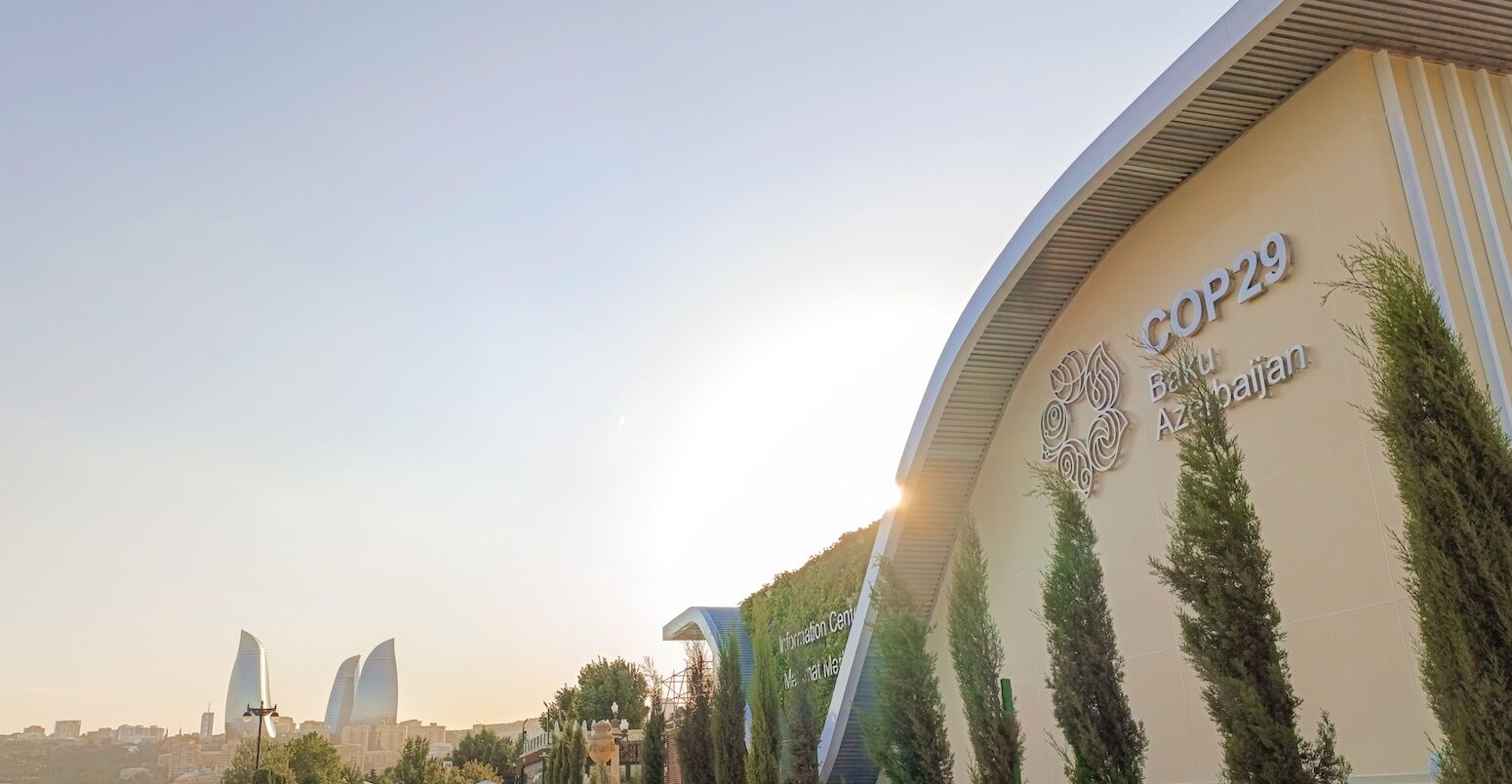
COP29: Key outcomes for food, forests, land and nature at the UN climate talks in Baku
Multiple Authors
11.27.24Despite taking place just days after a major UN biodiversity summit, the COP29 climate talks in Baku, Azerbaijan produced few new commitments on food, forests, land and nature.
Countries did finalise the text on the remaining sections setting out the rules for international carbon markets under Article 6 of the Paris Agreement.
They also considered a text “reaffirming” the “importance of conserving, protecting and restoring nature”.
However, countries failed to adopt this document during COP29’s chaotic final plenary session.
During the summit, three countries came forward with their new UN climate plans, which included limited information on how these nations plan to harness nature to meet their emissions targets.
Elsewhere, a flurry of new declarations and initiatives – including on climate action for farmers, water and reducing methane emissions from organic waste – made up the presidency’s “action agenda”.
Some observers lamented the apparent lack of progress on food and nature topics, with one telling Carbon Brief that the two featured “pretty weakly” in the final outcomes.
Others were more sanguine, with another observer saying that “momentum was neither gained nor lost, just maintained” and giving it, “overall, a passing grade”.
Below, Carbon Brief explains how food, forests, land and nature featured inside and outside the negotiations at COP29.
- Article 6
- Sharm el-Sheikh joint work on agriculture and food security
- Global Goal on Adaptation
- UAE Dialogue and the global stocktake
- Response measures
- Nature
- Food and nature in new NDCs
- Methane
- Food systems and water
- Deforestation
- Indigenous representation
- Greenwashing and ‘big ag’ influence
- Ecosystem restoration
Article 6
At COP29, countries reached a final agreement on the rules for carbon trading under Article 6 of the Paris Agreement.
The deal struck in Baku on Sunday brings a decade of negotiations to a close, but there are some key tools for “nature-based” removals and rights safeguards still to be developed.
Rules governing country-to-country carbon trading under Article 6.2, as well as a new international carbon market under Article 6.4 called the Paris Agreement Crediting Mechanism (PACM), are now more or less complete.
The COP29 presidency hailed the agreement as a “breakthrough” that “achieves full operationalisation of Article 6”, a COP “win” that it pushed from day one of the two-week talks.

The outcome was “warmly welcome[d]” by the International Emissions Trading Association (IETA). In an emailed statement, IETA said:
“We now call on all governments to make use of Article 6 and to implement policies that spur international market-based cooperation. By mobilising private investment where emission reductions and removals are more cost-effective, Article 6 has the potential to enhance climate ambition, transfer technology and deliver finance flows where most needed.”
Activist groups that are part of the Climate Land Ambition and Rights Alliance (CLARA), however, slammed what they said was a decision to “outsource” responsibilities to ensure human rights and environmental integrity to “a handful of people” comprising the supervisory body (SBM) for Article 6.4, which is tasked with drawing up guidance and approving methodologies.
In a statement responding to the overall outcome on Article 6, CLARA coordinator Kelly Stone from ActionAid USA said:
“Nothing in the rules developed here will prevent carbon markets from repeating their history of harming communities and failing to deliver meaningful climate action.
“It is not a coincidence that carbon markets were delivered at what was supposed to be the climate finance COP. When you talk to developed countries about climate finance, they throw up their hands and point to carbon markets and anything other than what’s needed and owed: public finance.”
Talks on Article 6 – which are highly technical – have repeatedly fallen short, with countries failing to reach any agreement at all during COP25 in Madrid and COP28 in Dubai.
In Baku, carbon markets were given high priority, with the presidency pushing through a day-one deal endorsing Article 6.4 documents on methodologies and removals. These documents had been “adopted” by the SBM rather than being negotiated line by line by countries.
The SBM had also drawn up a mandatory “sustainable development tool” with environmental and human-rights safeguards.
The guidelines on methodologies set out requirements for the downward adjustment of the “baselines” against which carbon credits can be issued – a process intended to align baselines with the Paris Agreement’s long-term goals. They also set out “additionality” checks to avoid projects “locking-in” high emissions.
Nevertheless, the manner in which these documents had been “adopted” by the SBM before the presidency pushed through formal endorsement on day one in Baku caused disquiet among some parties.
At the plenary on the first day of the summit, Tuvalu voiced its objection to this process, saying:
“We also recognise your interest in signalling progress. We have accepted this decision with some reluctance. Unfortunately, the manner in which we have adopted this decision at the start of the [COP] does not respect [a] party-driven process. We are very uncomfortable with this trend.”
Another COP29 decision, adopted at the closing plenary, “encourages” the supervisory body to “expedite” its work on baselines, additionality and the risk of removals being reversed. This is a particular concern for “nature-based solutions”, such as reforestation, given that increasingly frequent wildfires around the world could reverse these emission gains.
This decision also allows afforestation and reforestation projects created under the older “clean development mechanism” (CDM) to enter the new carbon market, subject to meeting rules on removals.
Effectively, afforestation and reforestation plantations from a pre-Paris era will be among the first projects allowed on the new market, without extra checks for additionality, or whether they actually achieved emissions reductions between 2021 to 2025.
While these projects form only a small percentage of CDM projects, experts told Carbon Brief that bringing them into Article 6.4 could “pave the way” for monoculture tree plantations to be considered removals.
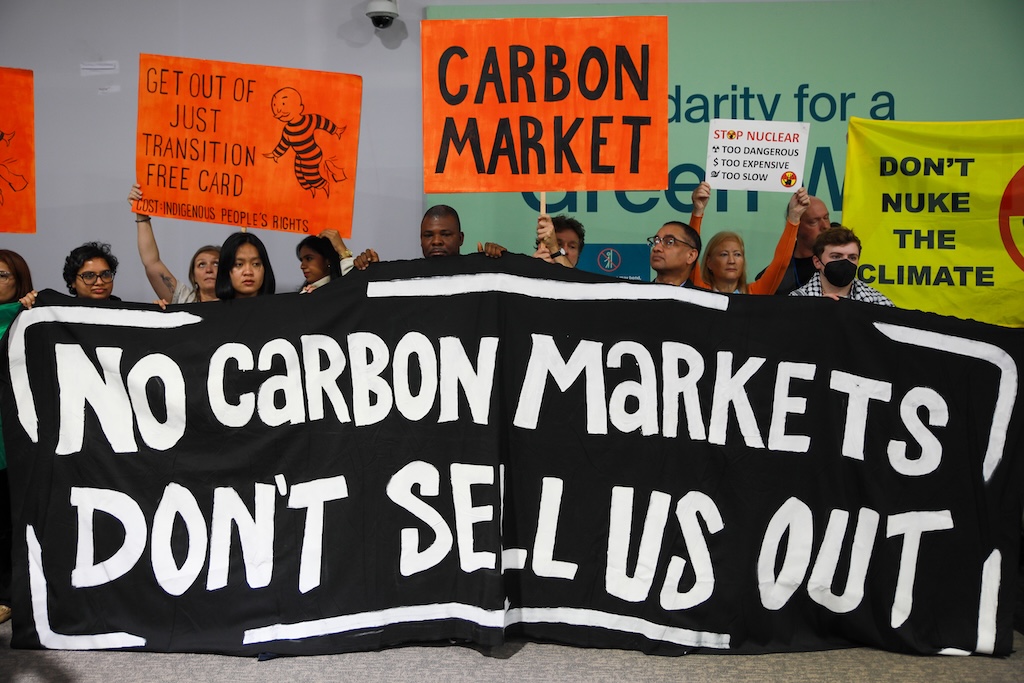
At the same time, COP29 also reached a decision on country-to-country carbon trading under Article 6.2.
The lack of official rules to this point has not deterred countries from striking their own deals. Many of these have been flagged by observers for their “glaring lack of transparency”.
The COP29 decision, however, “requests” more upfront disclosure from countries reporting on their activities, a key ask of countries and observers who fear this mechanism could become a secretive “wild west”, where trading can take place with limited transparency.
At the same time, the decision has lax consequences for “persistent” and “significant” inconsistencies in Article 6.2 projects, although countries will need to disclose these inconsistencies to the public.
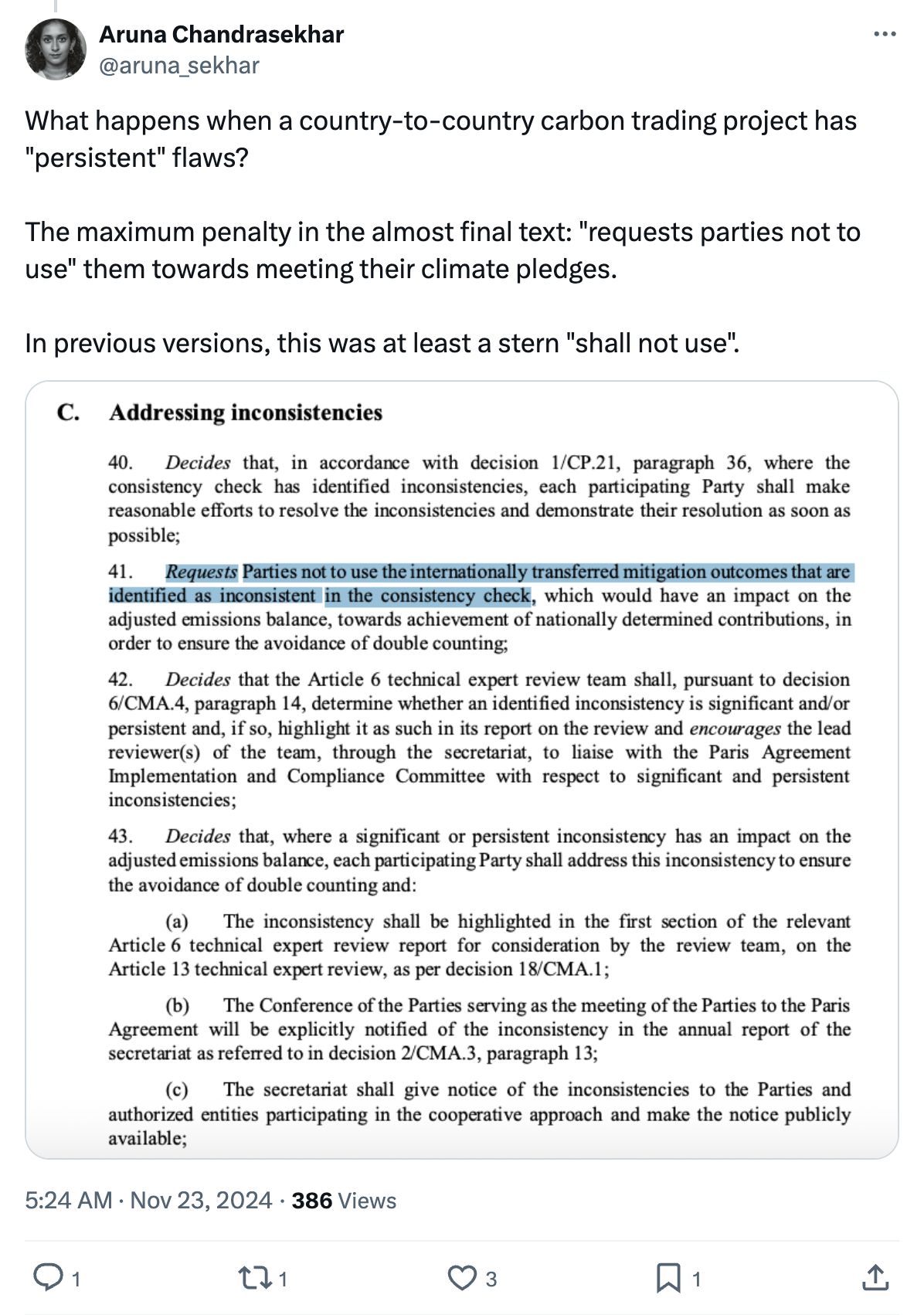
Isa Mulder from Carbon Market Watch told Carbon Brief:
“The option was on the table for much stronger language [that] made it through several iterations. So I think it was not impossible to get some teeth in there: just very difficult and it clearly didn’t succeed.”
Responding to the negotiations, UN special rapporteurs on human rights and climate change, as well as foreign debt, drew attention to transparency and rights concerns that linger in Article 6 carbon markets. In a statement on 19 November, they said:
“It is imperative to keep in mind that the public has a right to access information on carbon markets with regard to credible and verifiable evidence of emission reductions; expected impacts on land, waters, nature and human rights; as well as who is benefitting economically from carbon markets; and whether credits are being used to offset preventable emissions.
“This is even more important in a global context of widespread misinformation and disinformation on climate change and its impacts on human rights.”
Countries, however, were much more positive about the outcome. Blocs including the Alliance of Small Island States (AOSIS), the Environmental Integrity Group, the African Group and Australia welcomed the decision on carbon markets in the closing COP plenary.
During his final intervention, the EU’s commissioner for climate action Wopke Hoekstra said:
“We did deliver on Article 6 and this is a leap forward. We have witnessed a historic conclusion of the rule book for carbon markets. We now have standards that have a UN seal of approval on it, and this will drive investment, raise ambition and bring transparency and higher standards. This COP delivered on climate finance, it also delivered on trust…trusted rules on carbon markets.”
Finally, the talks in Baku agreed a deal on Article 6.8, spanning cooperation that does not involve markets.
Sharm el-Sheikh joint work on agriculture and food security
Despite having held more importance at previous COPs and featuring in the global stocktake last year, actual outcomes on agriculture were constructive but relatively muted in Baku.
There is only one formal negotiation track for agriculture and food systems at the UNFCCC, known as the Sharm el-Sheikh Joint Work on the Implementation of Climate Action on Agriculture and Food Security (SJWA).
At COP29, the debates on the SJWA were largely around the functions and structure of the Sharm el-Sheikh online portal, where countries and observers can submit information on how climate action can support agriculture and food security.
On the very first day of negotiations, Egypt sought to clarify “how small farmers can make submissions” and called for the website to be more accessible.
Later, the G77 group, led by the Dominican Republic and Kenya, proposed “enhancing” the portal to make it more usable, searchable by region and theme and to allow projects, initiatives and policies to seek collaboration and finance, such as from the Adaptation Fund.
Carbon Brief understands that, while this was initially resisted by Australia, Canada and the US, countries eventually agreed to consider a submission template developed by the G77, led by the Dominican Republic and Kenya and, later, Australia.
On 15 November, a clean four-page text with no brackets was approved at the mid-week plenary of the subsidiary bodies, wrapping up the negotiating track.
It includes a draft template for submissions and “request[s]” the UNFCCC secretariat to make the portal more accessible and functional, while developing further elements, such as how projects can link to financial or practical support.
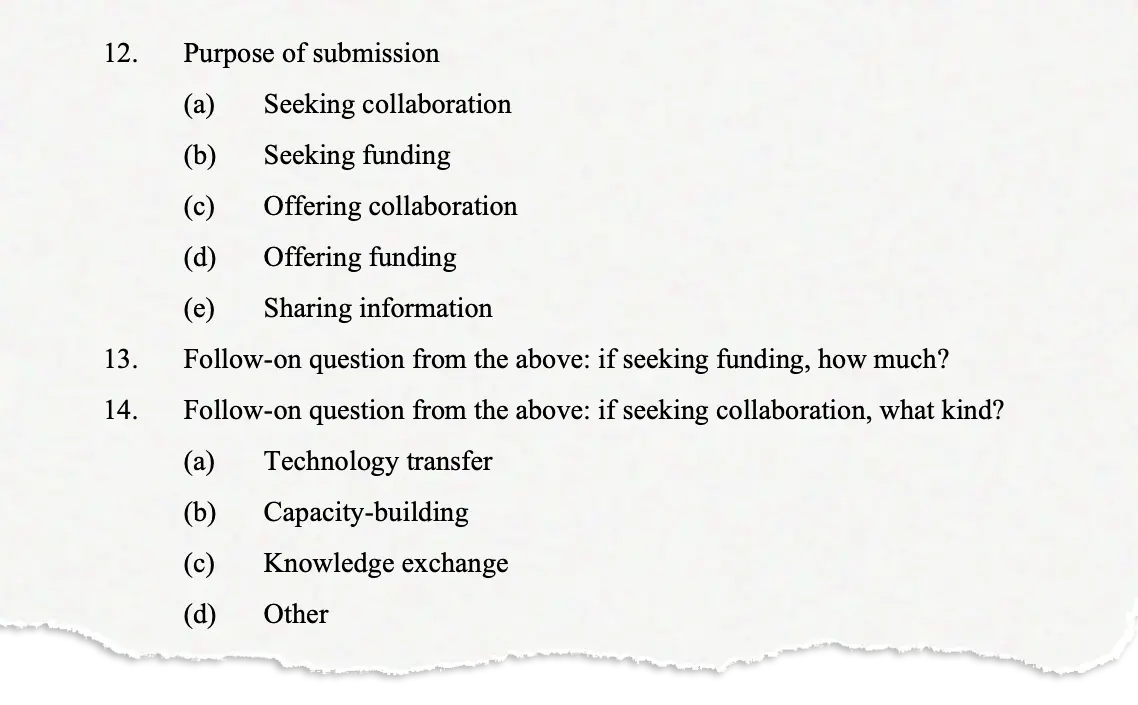
ActionAid’s global climate justice lead, Teresa Anderson, told Carbon Brief:
“In all, agriculture served a meagre salad this year. There was a low-key online portal discussion fight and an attempt to get the indicators on agriculture under adaptation to make sense.”
Global Goal on Adaptation
At COP28, countries agreed to ambitious but largely qualitative adaptation targets for food, water and ecosystems as part of the Global Goal on Adaptation (GGA).
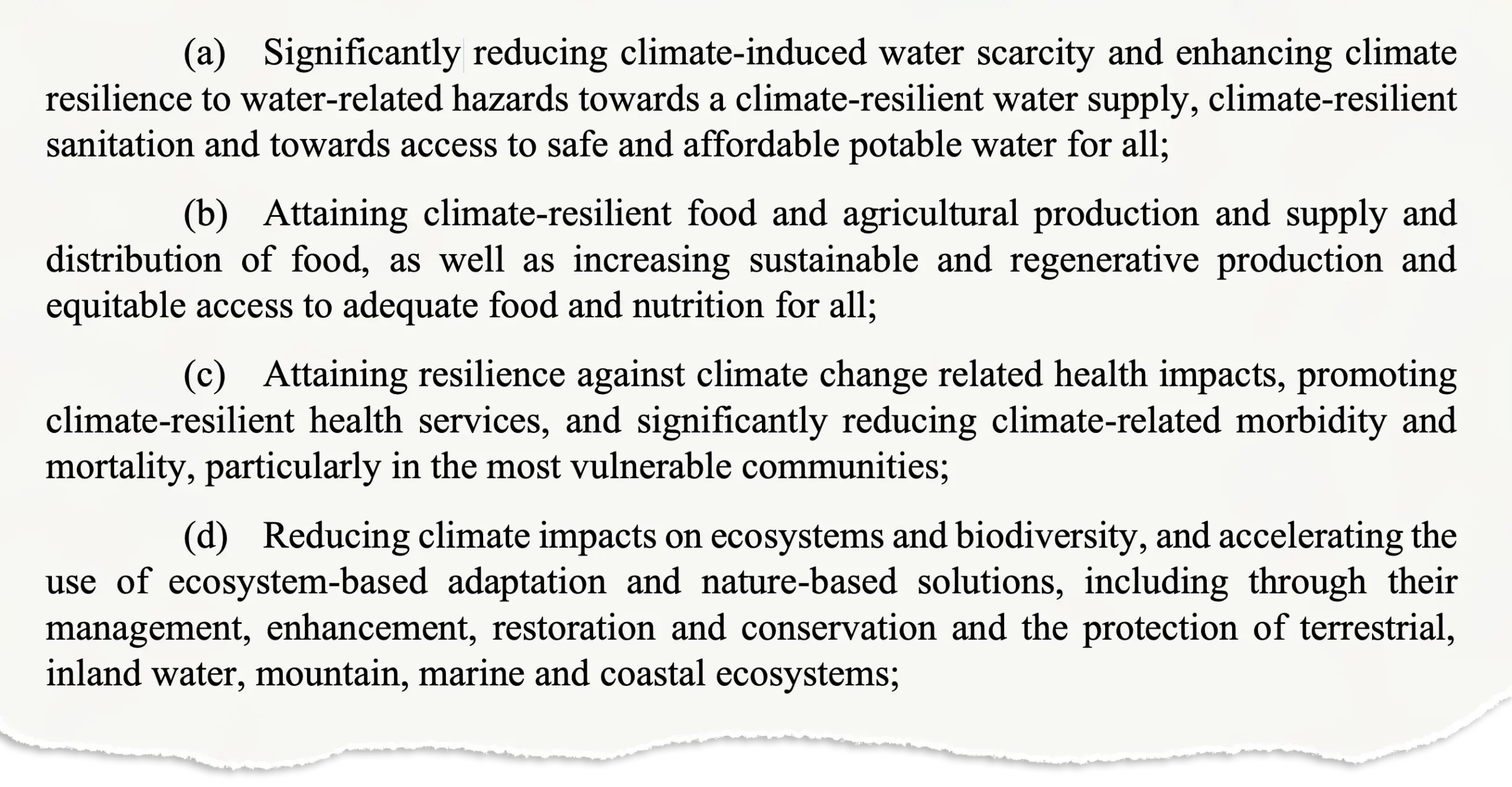
Indicators to translate these targets into achievable, but “globally comparable” actions and measure progress are still being developed by technical experts under the two-year UAE-Belem Work Programme.
Indicators “relevant to specific ecosystems” – such as marine, mountain and inland water ecosystems – were added to that list at COP29.
Crucially, experts will also have to draw up indicators for “enabling factors” that track – but are not limited to – “means of implementation (MOI)”, or how these adaptation actions are being financed, as well as progress towards “transformational” adaptation.
MOI indicators – widely understood to mean finance – were at the heart of the adaptation fight between developed and developing countries at COP29.
Observers told Carbon Brief that the EU, in particular, did not want MOI included, “as it was trying to balance expectations with regards to finance across the GGA and other tracks”.
The inclusion of “transformational adaptation”, such as “shifting entire farming systems to regenerative agricultural practices”, was also a subject of resistance from the like-minded developing (LMDCs) and least-developed countries (LDCs), as well as the African group and Arab group.
In a nine-hour meeting convened by the presidency to iron out differences, called the “Qurultay”, countries including Australia and the US opposed the establishment of MOI indicators for adaptation and emphasised the importance of “transformational” adaptation.
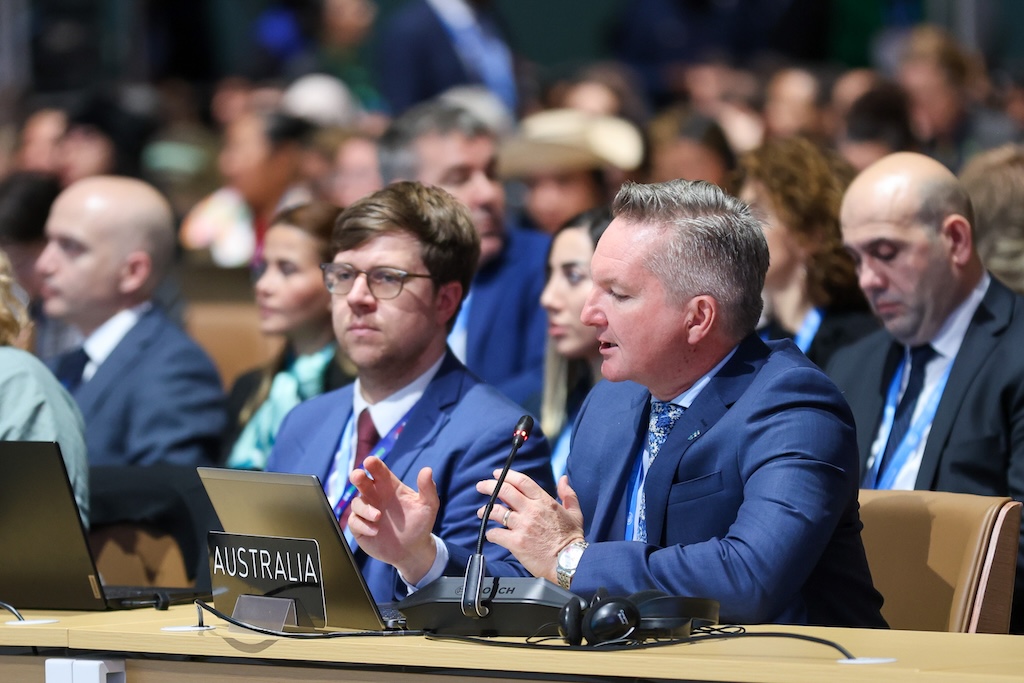
Meanwhile, developing countries – such as Pakistan and Zambia – pushed to include “means of implementation”. (See: Global Goal on Adaptation in Carbon Brief’s main COP29 summary.)
A “compromise” GGA text that went through nine iterations was published on 22 November, the scheduled last day of COP29, to the disappointment of many developing countries.
It encases MOI within “enabling factors”, which experts say could include other factors, such as transparency, governance or corruption.
This text was finally adopted, without intervention, in the closing plenary as the Baku Adaptation Roadmap.
Technical experts must now submit a consolidated list of all adaptation indicators to the subsidiary bodies four weeks before they meet in June next year. Parties will then have to pare that list down to “a manageable set of no more than 100 indicators” before they are adopted in COP30 in Brazil.
UAE Dialogue and the global stocktake
The UAE dialogue was established to follow up on the outcomes of the global stocktake (GST), a five-yearly “temperature check” for the Paris Agreement.
While some countries argued that the dialogue’s scope should be restricted to finance in order to support ambitious NDCs, many wanted it to cover “all outcomes” of the GST – particularly elements on mitigation.
(See where countries stood on the key issues in Carbon Brief’s interactive table of who wanted what from COP29.)
Much of the focus was on the fate of last year’s deal on transitioning away from fossil fuels, in the dialogue’s draft. However, discussions also included paragraph 33 of the global stocktake, which deals with biodiversity, terrestrial and ocean “sinks”.
For the first time, it had linked a zero-deforestation by 2030 target – a voluntary, non-negotiated pledge signed by 145 countries at COP26 – to the achievement of the Paris Agreement.

This paragraph was included in earlier iterations of text, but as an option and in brackets.
At a special single-sitting meeting called the “Qurultay”, Germany’s climate envoy, Jennifer Morgan, remarked that there was “no guarantee of a space to discuss the collective progress” on fossil fuel and forestry provisions in the stocktake. She added:
“This cannot, and must not be, our response to the suffering of millions of people around the world.”
In a press conference on 21 November, Bolivia’s lead negotiator, Diego Pacheco, clarified the stance of the Like-Minded Developing Countries (LMDCs), describing the inclusion of the targets as “a continued attempt by developed countries – which started in Glasgow – to “say 1.5C is within reach and transfer all responsibility” to developing countries. Pacheco added:
“At Baku, they are moving to having top-down targets for developing countries. If I don’t have the finance, how can I accept specific and intrusive targets?
“If we achieve sectoral targets [such as zero-deforestation by 2030], Bolivia will reach net-zero 20 years before developed countries. And that is really the best example of climate injustice. Is there any logic? This is real madness. They will say at the end ‘you have the Article 6 carbon markets’ [to deliver their financial obligations].”
(Bolivia is not among the 145 countries that signed the Glasgow Leaders’ Declaration on Forests and Land Use at COP26.)
A bracket-free draft decision for the UAE dialogue, published just before the closing plenary, “reaffirms the importance of conserving, protecting and restoring nature and ecosystems…in line with the Kunming-Montreal Global Biodiversity Framework”, the landmark nature deal agreed in 2022.
However, the COP29 presidency failed to find consensus to approve this text, meaning a decision on this has now been shunted to COP30 next year.
Response measures
At UN climate talks, “response measures” are a forum for discussing the effects of carbon-cutting policies on countries themselves. They are particularly relevant to nations where controls on emissions or deforestation pose a risk to their people and economy.
At COP29 in Baku, countries agreed on establishing a four-year work plan to discuss response measures for 2026-30.
Importantly, the work plan includes an item on the “cross-border impacts” of “measures taken to combat” climate change.
This means that trade-related climate measures – such as the EU’s deforestation regulation – now have a formal space to be discussed and their impacts assessed in UN climate talks.
Nature
COP29 started just over a week after the COP16 biodiversity summit wrapped up in Cali, Colombia.
Despite that, COP29 saw few new country initiatives on tackling nature loss or references to the need to tackle biodiversity loss and climate change together.
Ahead of the Baku summit, Azerbaijan, Colombia and Saudi Arabia – the presidencies of the climate COP29, biodiversity COP16 and desertification COP16, respectively – launched a “Rio trio” initiative at the UN general assembly meeting in New York in September.
The initiative is aimed at “enhancing synergies” between the three Rio conventions: the UN Framework Convention on Climate Change (UNFCCC); the Convention on Biological Diversity (CBD); and the Convention to Combat Desertification (UNCCD).
The presidency partially dedicated its last “thematic” day to nature on 21 November. This included a “high level” event on the Rio trio initiative.
However, the day coincided with the start of the endgame in the negotiations, meaning many of the event’s speakers failed to show up, including COP29 president Mukhtar Babayev, biodiversity COP16 president Susana Muhamad and desertification COP16 president Abdulrahman Abdulmohsen Alfadley.
At a side event attended by Carbon Brief, several speakers noted the lack of new initiatives on biodiversity at COP29 and urged delegates to look forward to COP30 next year, which is being held in the rainforest city of Belém, Brazil.
Speaking at the side event, Hugo Mendes, a representative from the Brazilian environment ministry working on synergies between climate and nature, said that his government was working closely with the COP16 biodiversity presidency to make sure nature “will be at the heart” of COP30.
He added that Brazil was working hard in negotiating rooms at COP29 to ensure tacking biodiversity loss was included in UAE dialogue, a text outlining how to take forward the outcomes of last year’s “global stocktake”.
A bracket-free draft decision for the UAE dialogue “reaffirms the importance of conserving, protecting and restoring nature and ecosystems…in line with the Kunming-Montreal Global Biodiversity Framework”, the landmark nature deal agreed in 2022.
However, as described above, the COP29 presidency failed to find consensus to approve this text, meaning a decision on this has now been shunted to COP30 next year. (See: UAE Dialogue and the global stocktake.)
Food and nature in new NDCs
Countries have until February 2025 to submit new national climate pledges, known as nationally determined contributions (NDCs).
NDCs are updated every five years under the Paris Agreement, with countries outlining how they intend to reduce greenhouse gas emissions as part of global efforts to limit warming.
Brazil, the UAE and UK were the early-bird countries who submitted their plans at COP29.
The UK’s full NDC has not yet been published, so it remains to be seen what that plan will outline for nature. But the country has pledged to cut emissions by 81% by 2035, compared to 1990 levels.
Below are some of the highlights from Brazil and the UAE’s climate plans relating to food, land and nature.
Brazil
Under its new climate pledge, Brazil plans to cut greenhouse gas emissions by 59-67% by 2035, compared to 2005 levels.
While setting a “band” of targets is not unheard of in NDCs, there is typically a much smaller disparity between the two targets.
These dual targets are “confirmation that [Brazil] could do much more” when it comes to its ambition, according to Claudio Angelo from Brazilian climate NGO group Observatório do Clima.
Deforestation was a major topic in the NDC for the world’s most biodiverse country, which is home to almost 60% of the Amazon Rainforest.
It outlined efforts to “achieve zero deforestation, by eliminating illegal deforestation” and making up for the emissions from the remaining “legal suppression of native vegetation”.
Observatório do Clima warned that this “still allows high levels of deforestation by 2035”. The pledge does not explicitly commit to reaching zero deforestation by 2030 – something the country’s president, Luiz Inácio Lula da Silva, has promised in the past.
But the Brazilian government has “done a very good job” to reduce deforestation levels in recent years, Dr Ane Alencar, the director of science at the Amazon Environmental Research Institute, told Carbon Brief.
On agriculture, an important sector for Brazil’s economy and a significant source of the country’s greenhouse gas emissions, Brazil is planning to encourage and incentivise more “sustainable” agriculture as part of its emissions-cutting efforts.
(Read Carbon Brief’s article on five key takeaways from Brazil’s NDC for more details, including on renewable energy, carbon markets and sustainable development.)
UAE
The UAE’s new climate pledge outlined plans to cut greenhouse gas emissions by 47% by 2035, compared to 2019 levels.
The plan received criticism from policy experts and NGOs for “failing to include any measures to restrain the production of oil and gas”, said the Cable, a Nigerian news outlet, with one expert describing it as a “greenwashing exercise”.
The country committed to cutting emissions from agriculture by 39% by 2035, compared to levels in 2019. This reduction will largely come from reduced energy emissions in the sector, the NDC said, noting that “emissions from the rising numbers of livestock [will] remai[n]”. The plan added:
“The implementation of advanced technologies, best practices and supportive policies are crucial in managing emissions from agriculture and ensuring the long-term sustainability of the UAE’s agricultural sector.”
Nature-based solutions, which are methods of using nature to mitigate and adapt to climate change, are one of the main ways in which the UAE said it plans to remove CO2 from the atmosphere. It will also rely on “engineering-based solutions”, the NDC added, such as carbon capture and storage.
It intends to plant an additional 160m mangroves by 2030, the NDC noted.
The pledge also referenced the Kunming-Montreal Global Biodiversity Framework, the nature deal signed off by almost every country in the world in 2022.
Methane
Methane featured in several events and pledges at COP29.
Agriculture is a major source of the potent, but short-lived, greenhouse gas – accounting for around 40% of human-caused methane emissions.
Speaking at a methane event in Baku, COP29 president Mukhtar Bubayev said that “action on non-CO2 greenhouse gas emissions is critical” to limit global warming. He noted that methane from organic waste, such as wasted food, is a “growing problem that demands urgent action”.
More than 30 countries signed up to the Reducing Methane from Organic Waste Declaration, a new pledge focused on setting sectoral targets in future NDCs to cut methane emissions from waste.
Brazil, the US, UK and the other signatories are responsible for almost half of global methane emissions from organic waste, according to the COP29 presidency.
The move will boost ambition “in the prevention, separate collection and improved management of organic waste…helping us keep food out of landfills”, Martina Otto, the head of the UN’s Climate and Clean Air Coalition, said in a statement.
The initiative is intended to support the Global Methane Pledge, which aims to slash overall methane emissions by 30% by 2030.
This pledge, first launched at COP26 in 2021, now has the backing of 159 countries. But experts are sceptical that its ambition will be met, as methane emissions are still rising.
Azerbaijan joined the pledge earlier this year, which COP29 president Babayev said “further strengthens” the country’s “reputation as a reliable green-energy partner to the world”. Tajikistan, Guatemala and Madagascar also joined this year.
On 12 November, the US, China and Azerbaijan held a summit on methane and other non-CO2 greenhouse gases in Baku.
Additional funding was also put towards methane reduction at COP29.
Governments and philanthropic organisations pledged almost $500m in new global grant funds for methane abatement, meaning more than $2bn has been raised for this issue in recent years, a Global Methane Pledge statement said.
The statement added that a funding initiative focused on enteric fermentation, launched at COP28 in Dubai, has so far raised more than $60m for research into “cost-effective breakthrough technologies to reduce livestock emissions”. These include ongoing projects into feed additives aimed at reducing methane from cattle.
The International Fund for Agricultural Development launched a guidebook intended to help developing countries weave ways of reducing methane from agriculture in their national climate plans. It particularly focused on emissions from livestock, rice production and organic waste.
Meanwhile, a new report launched during COP29 by the Changing Markets Foundation, a campaign group, identified “methane greenwashing tactics” in the climate commitments and initiatives from 22 “big meat and dairy” companies. (See: Greenwashing and ‘big ag’ influence.)
Food systems and water
During a high-level event in the first week of the summit, ministers and heads of state took stock of their progress towards the Emirates Declaration on Sustainable Food and Agriculture, announced at COP28 last year.
Participants at the event discussed integrating food systems into both NDCs and national adaptation plans, as well as increasing finance flows for food-systems transformation.
(A report from Climate Focus, released during COP29, found that only 14% of international public climate finance for agriculture was directed at small-scale farmers.)
Accompanying the Emirates Declaration at COP28 was the Alliance of Champions for Food Systems Transformation (ACF), which was also updated at this year’s summit.
The ACF is a group of five countries that have committed to taking stronger action and setting an example for food-systems transformation. The countries that initially made up the ACF are Brazil, Cambodia, Norway, Sierra Leone and Rwanda.
One of the key asks of the ACF countries is to integrate food systems into their updated NDCs, due in February 2025. (See: Nature in new NDCs.)
The ACF released a “progress snapshot” detailing actions that each country has taken – as well as priorities for future work – towards transforming food systems within their borders.
Tanzania and Vietnam both expressed their intent to, or interest in, joining the ACF during the summit.
Food systems were also both directly and indirectly included across several of the COP29 presidency’s action agenda items.
The Baku Harmoniya Climate Initiative for Farmers, hosted at the UN Food and Agriculture Organization, was officially launched on Tuesday 19 November, after having been announced earlier this year.
The Harmoniya initiative is focused on combining and streamlining the flows of information around climate action for farmers.
Its other stated objectives are increasing public and private investment in food systems by making it more attractive to investors and empowering farmers – especially women and youth – to adapt to climate change.
However, the Harmoniya initiative was not accompanied by any new pledges or commitments.
Clement Metivier, senior advisor for international advocacy at WWF-UK, said that the initiative “helps in maintaining much-needed momentum around food-systems transformation in the international climate process”. He told Carbon Brief:
“But to really make a difference on the ground, new initiatives and coalitions must mobilize finance for healthy, equitable and resilient food systems, and push governments to better integrate food in their national climate plans.”
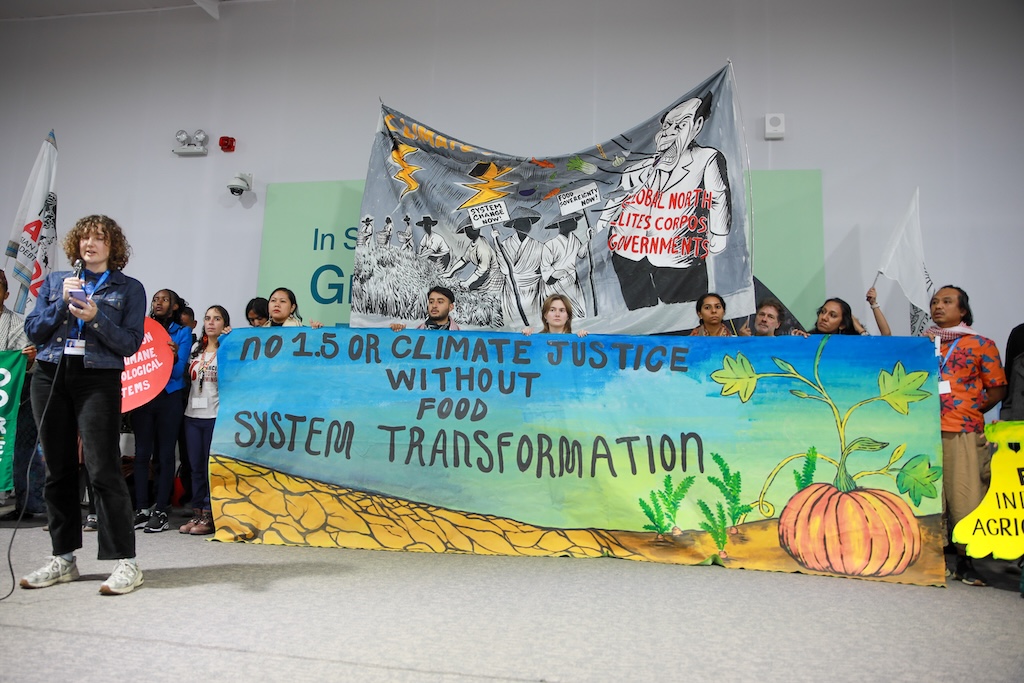
Food systems or food-related items were also mentioned in the Multisectoral Actions Pathways Declaration for Resilient and Healthy Cities, the Declaration on Enhanced Action in Tourism and the Declaration on Reducing Methane from Organic Waste. (See: Methane.)
The COP presidency also launched the Baku Declaration on Water for Climate Action, which was endorsed by nearly 50 countries, and the Baku Dialogue on Water for Climate Action. Going forward, the Dialogue will ensure formal discussions on water are on the agenda at subsequent COPs.
On the overall presence of food systems at COP29, Oliver Camp, environment and food systems advocacy advisor at the Global Alliance for Improved Nutrition, told Carbon Brief:
“Momentum was neither gained nor lost, just maintained – which, after the euphoria of Dubai and with the anticipation for Belem, may be all we needed…Overall, a passing grade: few exciting new launches and commitments, but we keep moving forward.”
Deforestation
Tropical deforestation, which accounts for around 20% of human-caused CO2 emissions, was scarcely mentioned at COP29.
The COP29 presidency’s action agenda did not mention deforestation or land-use change, meaning there were no new country pacts spearheaded by Azerbaijan.
The presidency did partially dedicate its last “thematic” day to nature on 21 November.
On this day, there was a “high-level” event on forests, which saw COP30 host Brazil’s environment minister, Marina Silva, emphasise the role of trees in tackling both environmental and social challenges.
However, the day coincided with the start of the endgame in the negotiations, meaning many of the event’s speakers failed to show up, including COP29 president Mukhtar Babayev and UK energy secretary Ed Miliband.
During the first week of the summit, UK foreign secretary David Lammy appeared at an event to announce new programmes under the Indigenous peoples and local communities’ forest tenure pledge, which was first launched at COP26 in Glasgow.
He told delegates that the UK will spearhead a 10-year, £50m programme “to reduce illegal logging and benefit forest people”, as well as a £94m programme “to strengthen forest communities’ voices in governance processes, particularly for the Amazon”. He also announced a “project to train local scientists in the Congo Basin”.
Separately at the summit, the UK announced a £239m package “to support forest-rich countries in protecting nature and tackling deforestation”.
Carbon Brief understands that all of these new programmes will be financed from existing money and do not represent new spending. The UK is currently far behind on meeting a promise to spend £1.5bn on protecting forests globally as part of its climate finance commitments between 2021 and 2026, Carbon Brief analysis shows.
Elsewhere at the summit, a new report launched by a coalition of environmental NGOs found that less than half of nations with more than 100,000 hectares of forest include a specific target to reduce emissions from deforestation in their UN climate pledges.
Indigenous representation
Indigenous peoples and local communities had less “momentum” at COP29 compared to the biodiversity COP, held just a few weeks earlier in Cali, Colombia, Clement Metivier, senior advisor for international advocacy at WWF-UK, told Carbon Brief.
Fany Kuiru Castro, leader of the Uitoto people in the Colombian Amazon and general coordinator of the Coordinating Body of Indigenous Organisations of the Amazon Basin (COICA), noted in a video interview with the environmental non-profit organisation Sachamama that, in Baku, “there [was] not much presence of Indigenous peoples from Latin America, especially from Amazon countries”.
Despite the limited representation of Indigenous participation at this climate summit, the main body representing them within the UNFCCC negotiations, the International Indigenous Peoples’ Forum on Climate Change (IIPFCC), was very clear in its position, highlighting that countries have failed to phase out fossil fuels and implement a just energy transition.
Among the IIPFCC’s chief demands was the creation of financial mechanisms for Indigenous peoples worldwide, including targeted funding under the new collective quantified goal on climate finance (NCQG) to support their conservation and restoration actions.
In fact, the main demand of Indigenous peoples at this COP was direct access to climate finance, Kuiru told Sachamama.
Following the COP’s conclusion, the IIFPCC condemned that the new collective funding goal did not explicitly mention human rights and Indigenous peoples’ rights, according to a statement released at the close of the negotiations.
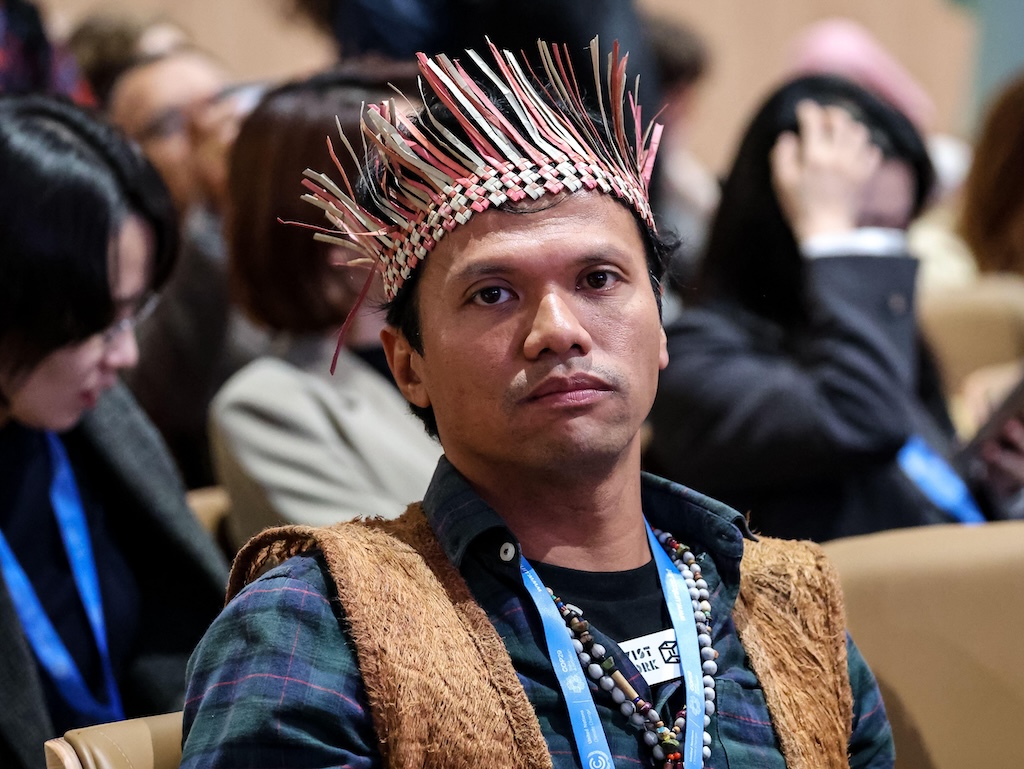
Metivier told Carbon Brief that this was “an opportunity that has been missed” since “[those] communities are doing critical work to tackle climate change and protect ecosystems”.
The IIFPCC also opposed carbon markets and the provision of loan finance, which increases the debt burden on developing countries. (See: Article 6.)
Elsewhere, COP29 adopted the Baku work plan to “bring the voice of Indigenous peoples and local communities to climate action”. This plan will seek to promote knowledge sharing, mainstream these knowledge systems into climate policies and actions, plus boost capacity building among Indigenous peoples and local communities.
The work plan will be implemented from 2025 to 2027 by the Facilitative Working Group (FWG) of the Local Communities and Indigenous Peoples Platform (LCIPP), which was established at COP24 in Katowice, Poland.
During the second week of COP29, the Global Forest Coalition, along with more than 30 civil society organisations, released the Baku Forest Declaration. This declaration seeks to push for the protection of forests and Indigenous rights in the negotiations, as well as the recognition of traditional knowledge in forest conservation.
The declaration says that forests should not be viewed solely as carbon sinks and recommends moving away from market mechanisms and carbon trading. Instead, the signatories call for climate policies to focus on community-based solutions, human rights and gender equality.
Greenwashing and ‘big ag’ influence
Concerns about greenwashing and lobbying are often raised at UN climate summits. COP29, held in the “petrostate” of Azerbaijan, was no different.
Before the summit took place, COP29 chief executive Elnur Soltanov was secretly recorded “discussing ‘investment opportunities’ in the state oil and gas company with a man posing as a potential investor”, BBC News reported, based on an investigation by Global Witness.
A separate Global Witness investigation found that more than 1,700 fossil-fuel lobbyists registered to attend COP29, lower than the record at COP28 but still larger than most party delegations. (See the Azerbaijani leadership section of Carbon Brief’s main COP29 summary for more.)
On the agriculture side, hundreds of “lobbyists for industrial farming” attended COP29, according to analysis from DeSmog and the Guardian. More than 200 delegates from agriculture companies and trade groups registered for the talks.
Nearly 40% of these travelled with delegations of countries, “giving them privileged access to diplomatic negotiations”, the Guardian noted.
DeSmog said that 52 delegates from the meat and dairy sector attended the talks, with 20 travelling alongside Brazil’s government. The delegates came from major organisations including JBS, the world’s largest meat processor, and Nestle, the largest food company in the world, the outlet found.
However, the number of “big meat and dairy” delegates at COP29 did not reach the record-high levels identified by DeSmog and the Guardian at last year’s summit.
Ahead of the Baku talks, Greenpeace Aotearoa (New Zealand) called for world leaders to “hold agri-business to account for its climate pollution”. Spokesperson Amanda Larsson said in a statement:
“The livestock industry is a major driver of climate pollution, but has largely flown under the radar at previous UN climate conferences.”
Elsewhere, almost 500 “carbon capture advocates” registered to attend COP29, according to analysis from non-profit organisation the Center for International Environmental Law (CIEL).
These include lobbyists from companies and groups advocating for carbon capture and storage, a method of removing CO2 from the atmosphere using technology. Almost half of the attendees were on national delegation badges, CIEL found, and the COP29 presidency invited 55 as guests.
The overall numbers are a slight increase compared to last year’s summit.
Ecosystem restoration
Overall, nature – and ecosystems and restoration, in particular – featured “pretty weakly” in the final COP29 texts, Metivier, from WWF-UK, told Carbon Brief.
According to a recent report published by WWF and other conservation organisations, 52% of forest countries have a quantified restoration target in their NDCs and 28% have a quantified deforestation target. (See: Nature in new NDCs.)
For William Baldwin-Cantello, director for nature-based solutions at WWF-UK, these differences could be explained by the greater ease of setting a restoration target in terms of hectares. However, he added:
“What’s more important than restoring ecosystems is preventing their loss.”
He noted that there was “no significant improvement in NDCs at COP with respect to existing restoration”, but said he hopes that this will change before the February 2025 deadline for the delivery of new NDCs and in the run-up to COP30 in Brazil.
The Climate Finance Group for Latin America and the Caribbean (GFLAC) noted in a statement that the text of the new collective quantifiable climate finance goal (NCQG) does not include a specific adaptation finance target. (See: Carbon Brief’s main summary of COP29 for more on the NCQG.)
In the closing days of COP29, the NGO Nature4Climate urged that the collective finance goal include funding specifically for the restoration and sustainable use of nature.
Baldwin-Cantello said that the absence of funding for adaptation and restoration could be due to donor governments’ fear of double counting biodiversity funding under the CBD and climate finance under the UNFCCC.
Some countries did announce new investments for restoring forests and ecosystems during COP29. El Salvador, for example, said it will invest $350m in the conservation and restoration of its largest river and watershed, while Canada announced that it will join the Freshwater Challenge to restore its freshwater ecosystems.
-
COP29: Key outcomes for food, forests, land and nature at the UN climate talks in Baku





